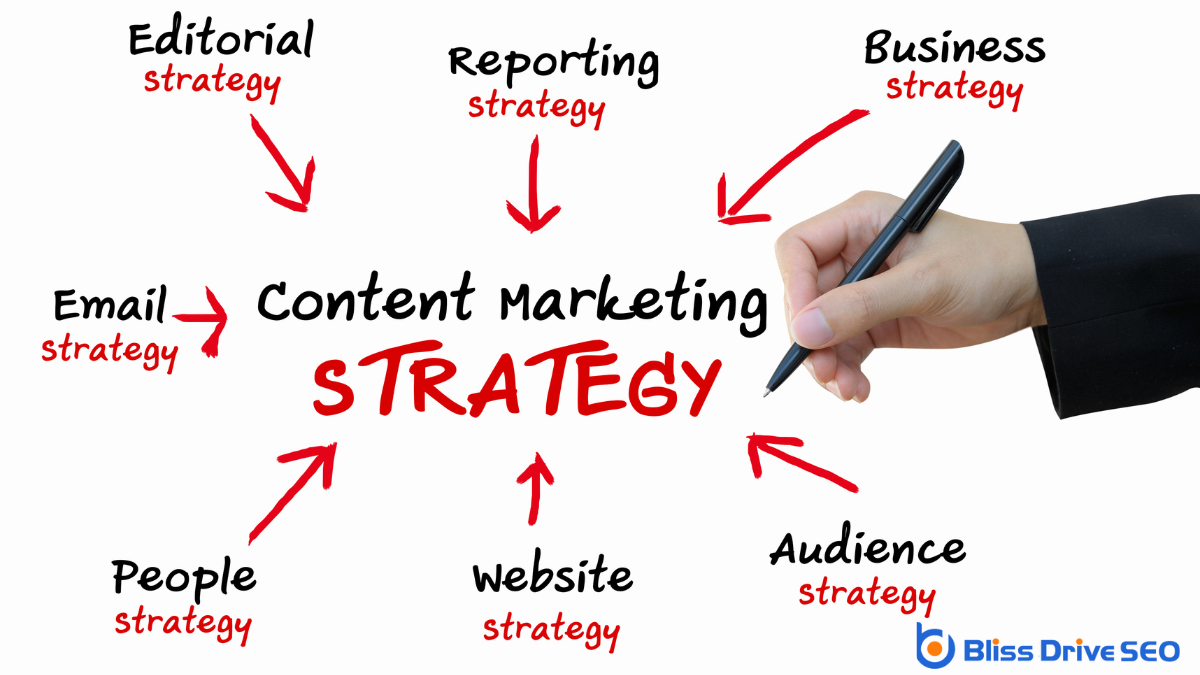Digital Marketing Services
Learn More About Us

Start your content marketingA strategic approach focused on creating and distributing valuable, relevant, and consistent content... strategy by defining your goals. Your objectives should be specific, measurable, achievable, relevant, and time-bound (SMART). By setting clear goals, you prevent aimless efforts and focus on what you want to achieve. Regularly referencing your written goals keeps your strategy aligned and on track. Without clear objectives, you risk creating content that doesn't serve your business or audience effectively. This foundational step guides all subsequent actions in your strategy, ensuring more targeted and efficient content creation. With clear goals in place, you'll access the next steps to successful content marketing execution.
When you're starting on your content marketing journey, defining your goals is essential to your success. Without clear objectives, your efforts might feel like shooting arrows in the dark. You need to know exactly what you want to achieve. Is it increasing brand awarenessThe extent to which consumers are familiar with the qualities or image of a particular brand., driving more traffic to your website, or boosting sales? Whatever it is, make sure your goals are specific, measurable, achievable, relevant, and time-bound (SMART). This clarity will guide your strategy and help you evaluate your progress.
Start by asking yourself, "What do I want my content to accomplish for my business?" Maybe you're looking to establish your brand as an industry thought leader, or perhaps you want to improve customer engagementThe level of interaction and involvement a customer has with a brand.. Write these goals down and refer to them regularly to keep your strategy aligned.
Once you've set your goals, prioritize them. Not all goals will have equal importance, and focusing on too many can dilute your efforts. By concentrating on a few key objectives, you'll make more significant strides.

To effectively achieve the goals you've set, understanding your audience is key. You can't create content that resonates if you don't know who you're speaking to.
Begin by defining your target audience. Consider their demographics, interests, and behaviors. Are they young professionals seeking career advice or parents looking for educational resources for their kids? This knowledge will shape the tone and style of your content.
Next, dig deeper into their needs and pain points. What challenges do they face, and how can your content offerThe specific product or service being promoted by affiliates. solutions? Engage with them directly, perhaps through surveys or social media interactions, to gather genuine insights. This interaction not only provides valuable information but also builds a connection with your audience, making them feel valued and understood.
Additionally, keep an eye on your competition. Analyze how they engage their audience and identify any gaps you could fill. This awareness allows you to tailor your content uniquely, ensuring it stands out.
Conducting a content audit is crucial for refining your content marketing strategy. It helps you understand what's working, what's not, and where you might've gaps. Start by gathering all your existing content—blog posts, videos, social media updates, and more. Organize them in a spreadsheet, noting titles, URLs, formats, and publication dates. This gives you a clear overview of what you've got.
Next, evaluate each piece of content. Look at performance metricsKey indicators used to measure the effectiveness of affiliate marketing efforts, such as clicks, con... like views, shares, and conversionThe completion of a desired action by a referred user, such as making a purchase or filling out a fo... rates to determine effectiveness. Is the content still relevant? Are there pieces that consistently perform well? Identify outdated content that might need a refresh or pieces that no longer align with your brand goals.
Consider the quality of your content. Are the messages clear and engaging? Does the content align with your audience's needs? This is your chance to spot inconsistencies and guarantee everything speaks with a unified voice.
An essential component of refining your content marketing strategy is researching competitors. By exploring what others in your industry are doing, you gain invaluable insights into successful tactics and potential pitfalls. Start by identifying your main competitors. Look at their websites, blogs, social media channels, and any other platforms where they publish content. Take note of the topics they cover, the formats they use, and the frequency of their posts.
Next, analyze their engagementThe interactions that users have with a brand’s content on social media.. Pay attention to the type of content that generates the most interaction, such as likes, shares, and comments. This information helps you understand what resonates with your shared audience. Also, look for gaps in their strategy. Are there topics they've overlooked or content types they're not utilizing? These gaps present opportunities for you to differentiate your content.
Consider using tools like SEMrush or Ahrefs to explore competitor analysisEvaluating the strengths and weaknesses of competitors’ SEO strategies. more deeply. These tools provide data on keywordsWords or phrases that users type into search engines to find information. they rank for, their traffic sources, and backlink profiles. Understanding this can guide your own keyword strategy and help improve your search engine visibility.

When deciding on content platforms, start by considering where your target audience spends their time online. Do they scroll through InstagramA photo and video-sharing social networking service owned by Facebook., engage in LinkedInA professional networking site used for career and business networking. discussions, or consume videos on YouTube? Identifying these spaces is essential because you want your content to meet them where they are. It's not just about being present; it's about being present in the right places.
Next, evaluate the type of content you plan to create. Are you focusing on visuals, long-form articles, or quick tips? Each platform has its strengths. Instagram and PinterestA visual discovery and bookmarking platform where users can find and save ideas. are ideal for visual contentImages, videos, and other visual elements used to engage users and improve conversion rates., while LinkedIn is perfect for professional insights and articles. If video content is your strength, YouTube or TikTokA social media platform for creating, sharing, and discovering short music videos. could be your platforms of choice.
To wrap up, start by defining your goals to set a clear direction. Know your audience inside and out to tailor content that resonates. Conduct a content audit to identify strengths and gaps in your current strategy. Research your competitors to spot opportunities and trends you can leverage. Finally, choose the right content platforms to effectively reach your audience. By following these steps, you'll build a solid foundation for a successful content marketing strategy.
